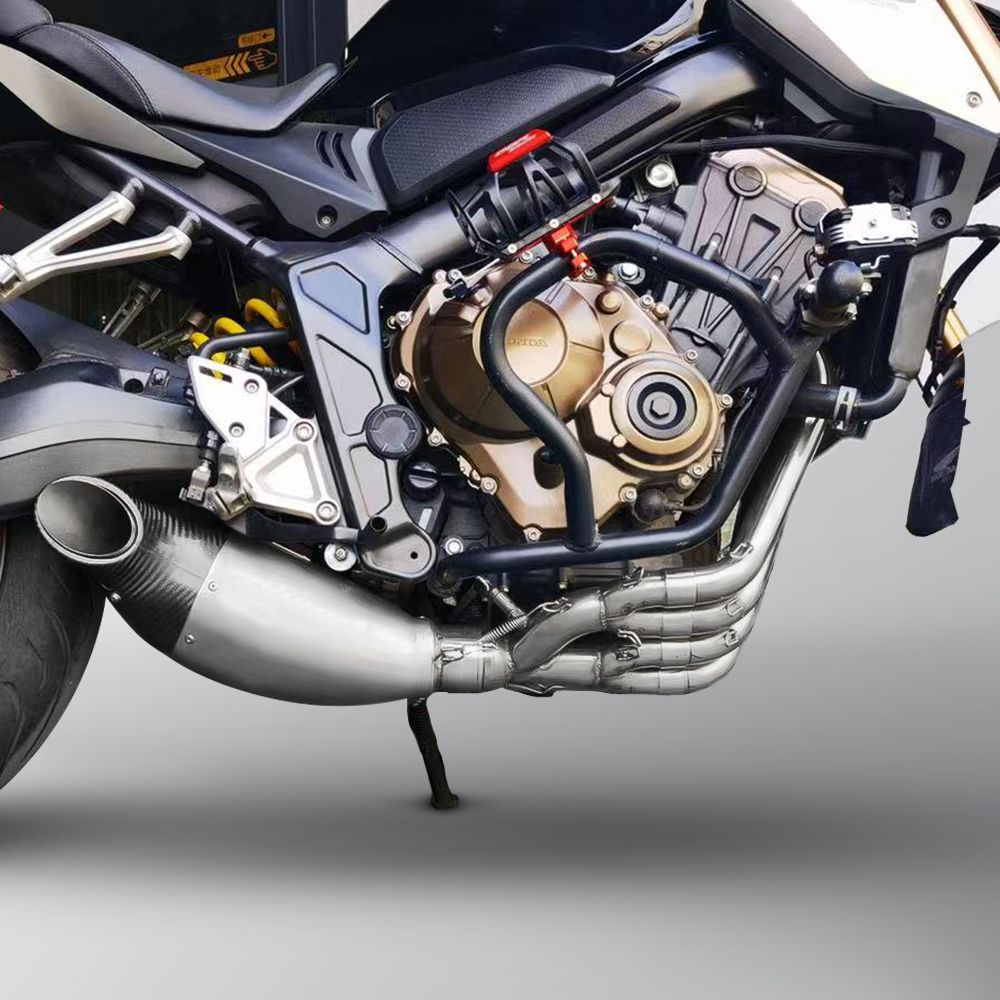When it comes to upgrading your motorcycle, one of the most popular and impactful modifications you can make is installing an aftermarket motorcycle exhaust. Riders all over the world choose to replace their stock exhaust systems for better performance, a deeper sound, and a more personalized look. Whether you’re a daily commuter, a weekend warrior, or a track enthusiast, an aftermarket exhaust can dramatically transform your riding experience.
In this detailed guide, we’ll explore everything you need to know about aftermarket motorcycle exhausts — from the different types and benefits to installation tips and legal considerations.
What Is an Aftermarket Motorcycle Exhaust?
An aftermarket motorcycle exhaust is a replacement exhaust system designed and manufactured by companies other than the motorcycle’s original manufacturer. The stock exhausts that come with new motorcycles are built to meet noise regulations, emissions standards, and cost constraints. While they perform adequately, they often restrict the engine’s full potential.
Aftermarket exhausts, on the other hand, are engineered to optimize performance, reduce weight, enhance sound, and improve aesthetics. They come in various configurations, materials, and designs — giving riders the flexibility to choose one that matches their specific goals and preferences.
Types of Aftermarket Motorcycle Exhaust Systems
Before investing in an aftermarket system, it’s essential to understand the different types available. Each type offers unique benefits in terms of performance, sound, and appearance.
1. Slip-On Exhaust
A slip-on exhaust replaces only the muffler section of the system, keeping the stock headers and mid-pipes intact.
- Advantages: Affordable, easy to install, and significantly improves sound.
- Performance Gain: Modest horsepower increase due to better exhaust flow.
- Best For: Riders who want a louder, more aggressive exhaust note without spending too much.
2. Full System Exhaust
A full system replaces the entire exhaust setup, including headers, mid-pipes, and mufflers.
- Advantages: Maximum performance improvement, reduced weight, and complete style transformation.
- Performance Gain: Noticeable horsepower and torque boost.
- Best For: Performance-focused riders or racers who want the most out of their engine.
3. High-Mount and Low-Mount Exhausts
These refer to the placement of the muffler.
- High-Mount: Positioned near the tail for sporty aesthetics and better cornering clearance.
- Low-Mount: Placed lower for a sleeker profile and center-of-gravity balance.
4. Underbelly Exhaust
Mounted underneath the bike, underbelly systems provide a centralized weight distribution and a clean, modern look.
Key Benefits of Aftermarket Motorcycle Exhausts
Upgrading to an aftermarket exhaust system can bring multiple benefits that go beyond just sound and looks. Let’s break them down:
1. Enhanced Performance
The primary reason most riders upgrade their exhaust is to improve performance. Aftermarket systems are designed to allow better airflow, reducing backpressure and enabling the engine to breathe more freely. This leads to:
- Increased horsepower
- Improved throttle response
- Better torque across RPM ranges
Combined with proper tuning, the performance boost can be significant.
2. Weight Reduction
Stock exhausts are often made of heavy steel and bulky components. Aftermarket exhausts, on the other hand, use lightweight materials such as titanium, carbon fiber, or stainless steel. Reducing weight improves handling, acceleration, and fuel efficiency — all crucial for performance-oriented riders.
3. Distinctive Sound
One of the most noticeable benefits of an aftermarket motorcycle exhaust is the sound. Riders can choose systems that deliver deep, throaty roars or aggressive racing tones. The enhanced exhaust note not only improves rider satisfaction but also increases road presence and safety.
4. Aesthetic Appeal
An aftermarket exhaust can completely change your bike’s look. From sleek carbon fiber finishes to polished titanium pipes, these systems add a touch of personality and sophistication to your motorcycle’s design.
5. Improved Durability
High-quality aftermarket exhausts are built to last. Many feature superior construction techniques and corrosion-resistant materials that can withstand heat, moisture, and vibration better than stock systems.
Popular Materials Used in Aftermarket Exhausts
The material of your aftermarket exhaust plays a major role in performance, durability, and cost. Here are the most common ones:
1. Stainless Steel
Durable, cost-effective, and resistant to rust — stainless steel exhausts are a great balance between price and performance.
2. Titanium
Known for being ultra-lightweight and heat-resistant, titanium exhausts offer top-tier performance but come with a higher price tag.
3. Carbon Fiber
These exhausts are favored for their sleek appearance and lightweight build. However, they may not be as durable as metal-based systems under extreme conditions.
4. Aluminum
Lightweight and affordable, aluminum exhausts are a good entry-level choice, though they may discolor over time due to heat exposure.
Installation and Tuning Tips
Installing an aftermarket motorcycle exhaust can be relatively straightforward, especially for slip-on systems. However, to achieve optimal performance and avoid engine issues, proper installation and tuning are crucial.
1. Follow Manufacturer Instructions
Each exhaust system comes with specific installation guidelines. Always read and follow them carefully to avoid leaks or misalignment.
2. Use Quality Gaskets
Old or damaged gaskets can cause exhaust leaks. Replace them during installation to ensure a proper seal.
3. ECU Remapping
When you change your exhaust, the engine’s air-fuel ratio may need adjustment. ECU remapping or using a fuel controller helps your engine adapt to the new exhaust system for maximum power and efficiency.
4. Check Clearance
Ensure that your new exhaust doesn’t interfere with footpegs, fairings, or swingarms.
5. Professional Installation
If you’re not confident in your mechanical skills, it’s best to have a professional handle the installation. Incorrect fitting can affect performance and safety.
Maintenance and Care for Your Aftermarket Exhaust
After installation, regular maintenance ensures your exhaust stays in top condition.
- Clean Regularly: Use mild cleaners suitable for the exhaust material. Avoid abrasive chemicals that can damage finishes.
- Inspect for Leaks: Check joints and clamps periodically.
- Tighten Bolts: Vibration from riding can loosen bolts over time.
- Avoid Excessive Water Exposure: While most exhausts are corrosion-resistant, prolonged exposure to moisture can reduce lifespan.
Legal and Environmental Considerations
Before installing an aftermarket motorcycle exhaust, it’s essential to be aware of local laws and noise regulations. Some aftermarket systems may exceed legal decibel limits or lack emission controls.
- Noise Regulations: Always choose exhausts that comply with noise standards in your region. Excessive sound can result in fines or penalties.
- Emissions Compliance: Many countries require catalytic converters to reduce emissions. Make sure your aftermarket exhaust either includes one or retains the stock converter.
Responsible riders should strike a balance between performance and environmental responsibility.
Choosing the Right Aftermarket Exhaust
With countless brands and styles available, selecting the best aftermarket exhaust depends on your goals and motorcycle type. Here are some factors to consider:
- Riding Style: Do you ride for leisure, sport, or long-distance touring? Your exhaust should match your riding needs.
- Budget: Slip-on systems are more affordable, while full systems offer greater performance but at a higher cost.
- Brand Reputation: Choose reputable manufacturers known for quality and durability.
- Sound Preference: Listen to sound samples online or at dealerships before deciding.
- Weight and Material: Opt for lightweight materials if performance is your priority.
Performance Tuning After Installation
Once you’ve installed your aftermarket exhaust, fine-tuning can unlock its full potential. Combining your exhaust upgrade with an air filter upgrade and ECU remap can significantly enhance performance metrics like horsepower, torque, and fuel efficiency.
Final Thoughts
An aftermarket motorcycle exhaust isn’t just a mechanical upgrade — it’s a statement of personality, performance, and passion. From a louder roar that announces your presence on the road to the noticeable improvement in acceleration and handling, the benefits are undeniable.
However, the best results come from balancing sound, performance, and legality. Always choose a system that fits your bike model, your riding goals, and your regional laws. Whether you’re looking for that deep rumble on city streets or razor-sharp performance on the track, upgrading your exhaust can breathe new life into your motorcycle.

